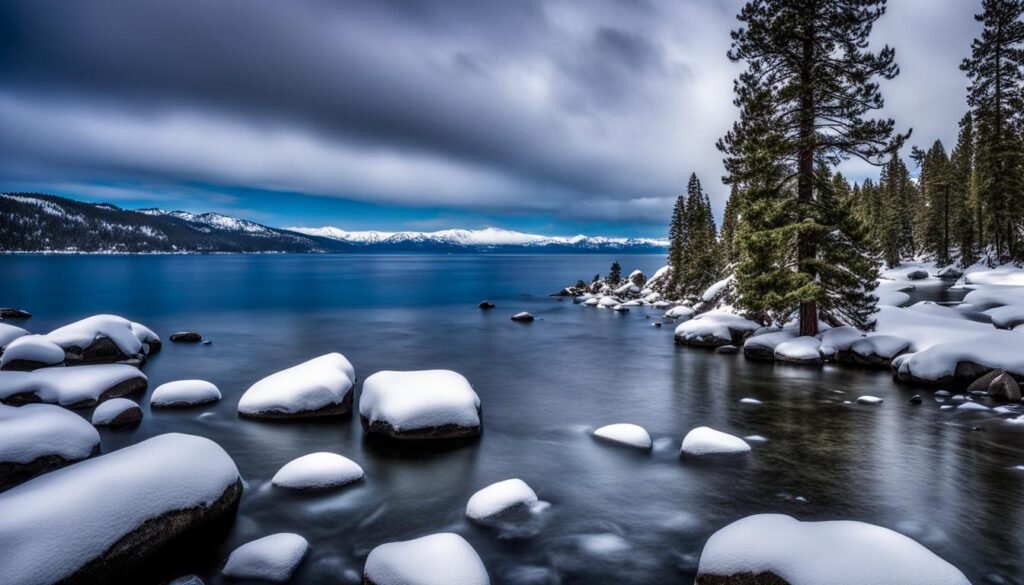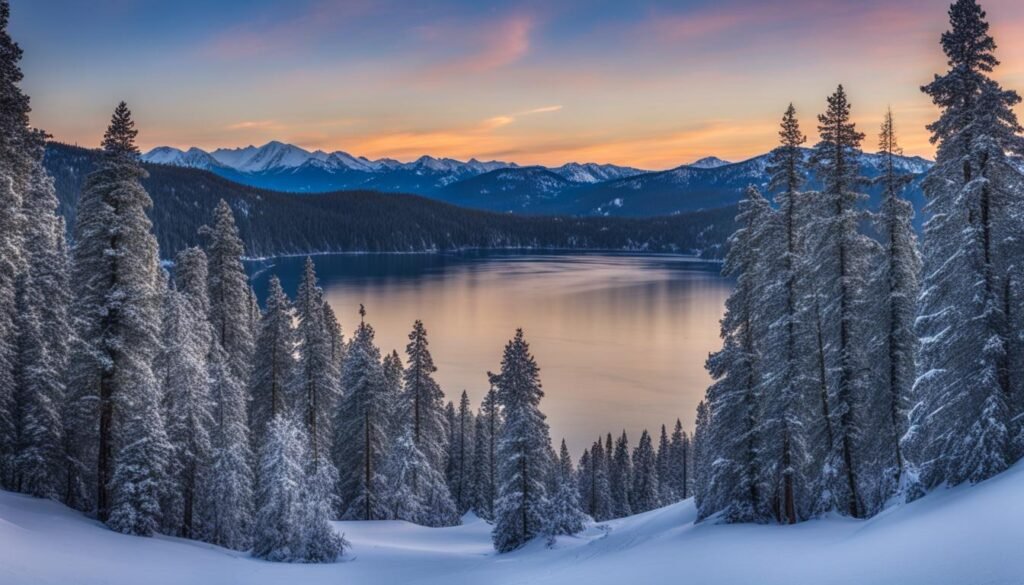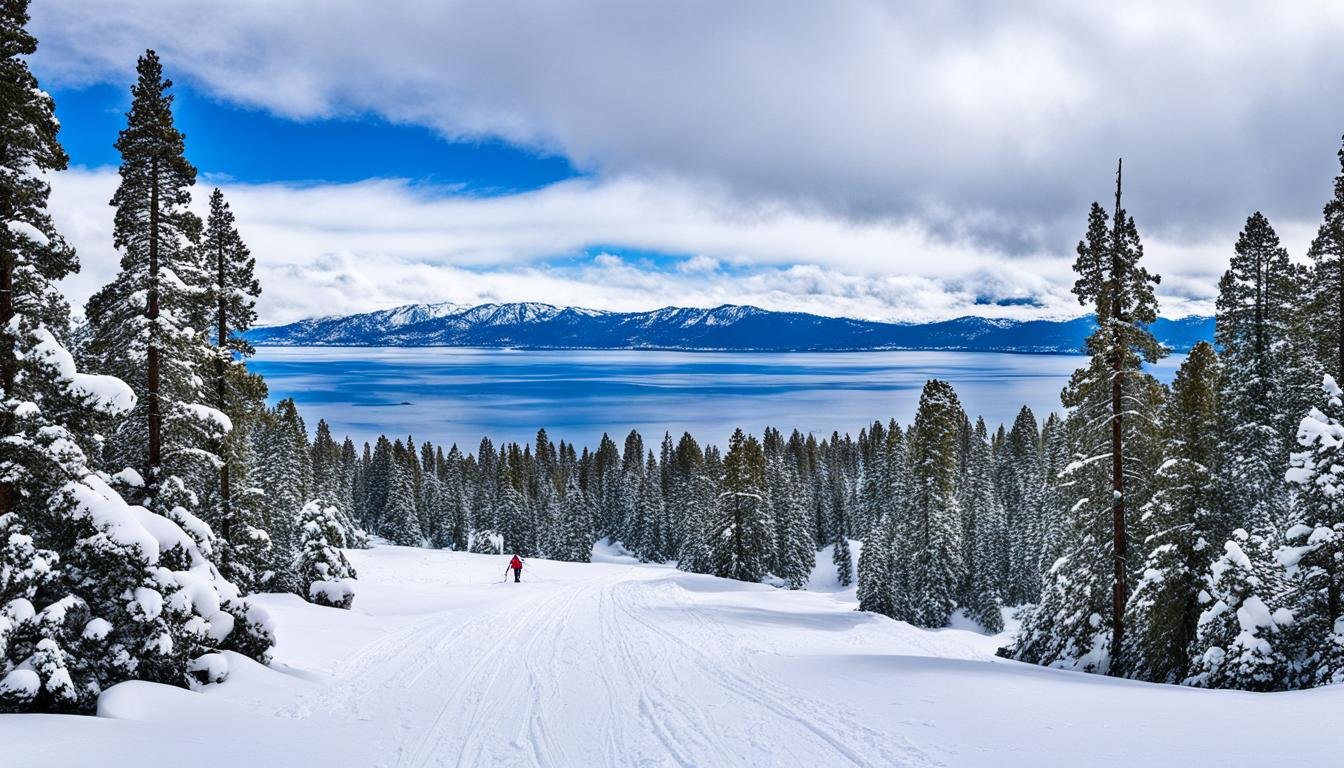When planning a winter getaway, one of the questions that often comes to mind is whether or not there will be snow. Lake Tahoe, located in the Sierra Nevada mountain range, is a popular destination for winter sports enthusiasts and nature lovers alike. But does it snow in Lake Tahoe?
The answer is a resounding yes! Lake Tahoe is famous for its snowy winters, with an average annual snowfall of over 300 inches. The region’s high elevation and proximity to the mountains make it a prime location for snowfall.
From December to March, visitors can expect to see a winter wonderland in Lake Tahoe. The snow-covered landscapes create a picturesque backdrop for a variety of outdoor activities, including skiing, snowboarding, snowshoeing, and sledding.
So if you’re looking for a snowy escape, Lake Tahoe is the place to be!
Key Takeaways:
- Lake Tahoe experiences significant snowfall during the winter months.
- The average annual snowfall in Lake Tahoe is over 300 inches.
- Winter activities such as skiing and snowboarding are popular in Lake Tahoe.
- December to March is the peak snowfall season in Lake Tahoe.
- Lake Tahoe offers a picturesque winter landscape for outdoor enthusiasts.
When Does it Snow around Lake Tahoe?
Lake Tahoe region is known for its stunning beauty and famous for its winter activities. Snowfall in this area is a significant factor that attracts visitors from near and far. If you are planning a trip to Lake Tahoe, it is important to know when you can expect to see snow. Let’s explore the snowfall patterns in the region month by month.
Snowfall in December
December marks the start of the winter season in Lake Tahoe, and snowfall becomes more frequent. The snow-covered landscape creates a picturesque winter wonderland, setting the perfect backdrop for holiday celebrations. Ski resorts around Lake Tahoe usually start their winter operations around this time, ensuring that visitors can enjoy the fresh powder on the slopes.
Snowfall in January
January is typically the snowiest month in Lake Tahoe, with consistent snowfall throughout the month. The region receives abundant snowfall during this time, making it ideal for skiing, snowboarding, and other winter activities. The deep snowpack creates excellent conditions for both beginners and advanced skiers, guaranteeing a thrilling and enjoyable experience on the slopes.
Snowfall in February
February continues to bring significant snowfall to Lake Tahoe, maintaining the excellent conditions for winter sports enthusiasts. The sunny days and fresh powder make it the perfect time to hit the slopes and take advantage of the wide range of skiing and snowboarding options available in the area. From groomed trails to challenging backcountry terrain, there is something for everyone to enjoy.
Snowfall in March
March signals the transition from winter to spring in Lake Tahoe. While the snowfall may become less frequent during this time, the region still receives snow as spring approaches. The beautiful scenery combined with relatively milder temperatures makes March an ideal time for outdoor activities like snowshoeing and snowmobiling. Many ski resorts extend their operating seasons into March, allowing visitors to make the most of the remaining snow.
As the seasons change, the snowfall in Lake Tahoe adds to the charm and allure of the region. Whether you visit in December, the snowiest month, or March, when the snow begins to melt, you can expect breathtaking views and plenty of opportunities to enjoy winter sports. Plan your trip accordingly and experience the magic of Lake Tahoe in the snow!
Where Does it Snow around Lake Tahoe?

When it comes to snowfall, Lake Tahoe and its surrounding areas offer plenty of options for snow enthusiasts. Whether you’re looking for a winter wonderland experience or want to hit the slopes, there are several locations around Lake Tahoe where you can enjoy the beauty of the snow. Let’s take a closer look at three popular destinations:
Snow in Tahoe City
Tahoe City, located on the northwest shore of Lake Tahoe, receives ample snowfall during the winter months. With an average annual snowfall of over 300 inches, this charming town is perfect for outdoor activities like skiing, snowboarding, and snowshoeing. The picturesque landscapes and breathtaking views make Tahoe City a must-visit destination for snow lovers.
Snow in South Lake Tahoe
South Lake Tahoe is another fantastic location for snow enthusiasts. This bustling city offers a wide range of winter activities, including skiing, snowboarding, and snowmobiling. Surrounded by stunning mountains and pristine forests, South Lake Tahoe receives an average of 125 inches of snowfall each year. Prepare for an unforgettable winter adventure in this beautiful destination.
Snow in Stateline
Situated on the eastern shore of Lake Tahoe, Stateline is known for its world-class ski resorts and abundant snowfall. With an average annual snowfall of approximately 400 inches, Stateline provides ideal conditions for skiing and snowboarding enthusiasts. Whether you’re a beginner or an experienced skier, Stateline offers a range of slopes and trails for all skill levels.
| Location | Average Snowfall (inches) |
|---|---|
| Tahoe City | 300+ |
| South Lake Tahoe | 125 |
| Stateline | 400+ |
Ski Resorts Around Lake Tahoe
When it comes to skiing around Lake Tahoe, there are several world-class ski resorts to choose from. Whether you’re a seasoned professional or a beginner hitting the slopes for the first time, these resorts offer breathtaking views and exceptional skiing opportunities.
Heavenly Mountain Resort
Heavenly Mountain Resort is one of the most popular ski resorts in the Lake Tahoe area. Located on the south shore of the lake, it offers over 4,800 acres of skiable terrain and boasts the highest elevation in the region. With a variety of trails for all skill levels, including some of the steepest slopes in North America, Heavenly is a favorite destination for adrenaline seekers. The resort also offers breathtaking panoramic views of Lake Tahoe, making it a truly memorable skiing experience.
Squaw Valley
Squaw Valley, host of the 1960 Winter Olympics, is another renowned ski resort in the Lake Tahoe region. Located in Olympic Valley, it offers over 3,600 acres of skiable terrain and is known for its challenging slopes and diverse terrain parks. Squaw Valley has a rich skiing history and has hosted numerous national and international skiing events. With its stunning alpine scenery and world-class facilities, it’s no wonder that Squaw Valley attracts skiers from all over the world.
Diamond Peak
For those looking for a more intimate and family-friendly skiing experience, Diamond Peak is a fantastic choice. Located near Incline Village on the northeast shore of Lake Tahoe, this quaint resort offers 655 skiable acres and breathtaking views of the lake. Despite its smaller size, Diamond Peak offers a variety of well-groomed trails for skiers of all levels. The resort also prides itself on its affordable lift ticket prices, making it a great option for budget-conscious skiers.
| Ski Resort | Location | Skiable Terrain | Notable Features |
|---|---|---|---|
| Heavenly Mountain Resort | South Lake Tahoe | 4,800 acres | Highest elevation, stunning lake views |
| Squaw Valley | Olympic Valley | 3,600 acres | Challenging slopes, historic Olympic site |
| Diamond Peak | Incline Village | 655 acres | Affordable prices, family-friendly |
When Does it Snow around Lake Tahoe?

In Lake Tahoe, snowfall is a common occurrence during the winter months. Let’s take a closer look at the snowfall patterns in December, January, February, and March.
Snowfall in December
December marks the beginning of the winter season, and snowfall becomes more frequent in the Lake Tahoe region. The average snowfall in December is around X inches, creating a beautiful winter wonderland for visitors and locals alike. The picturesque landscape covered in fresh snow offers a perfect setting for various winter activities.
Snowfall in January
As we move into January, Lake Tahoe experiences even more snowfall, with an average of Y inches. The snow-capped mountains and the glistening lake provide breathtaking views that attract winter sports enthusiasts from all over the world. Whether you’re an avid skier, snowboarder, or simply want to enjoy the serene beauty of the snow-covered landscapes, January offers plenty of opportunities for outdoor fun.
Snowfall in February
In February, Lake Tahoe continues to receive heavy snowfall, with an average accumulation of Z inches. With the mountain resorts fully operational and the slopes covered in fresh powder, this month is an ideal time for skiing and snowboarding enthusiasts to hit the slopes. The region’s world-class ski resorts offer a wide range of trails for all skill levels, ensuring an unforgettable winter adventure.
Snowfall in March
As winter transitions into spring, Lake Tahoe still receives considerable snowfall in March, with an average of W inches. This is a great time to enjoy the slopes and take advantage of less crowded ski resorts, as the winter peak season starts to wind down. The snow conditions remain excellent, making it an opportune time for a late-season getaway to Lake Tahoe.
With its consistent winter snowfall, Lake Tahoe offers unparalleled opportunities for winter sports and outdoor adventures. Whether you plan to visit in December, January, February, or March, you can expect a winter wonderland filled with endless snowy delights.
Where Does it Snow around Lake Tahoe?
In addition to Tahoe City and South Lake Tahoe, another popular location where snow can be found around Lake Tahoe is Stateline. Located on the eastern shore of the lake, Stateline is home to several ski resorts and offers a variety of winter activities for visitors.
Snow in Tahoe City
Tahoe City, situated on the northwest shore of Lake Tahoe, receives significant snowfall during the winter months. The average annual snowfall in Tahoe City is around 207 inches, making it an ideal destination for snow enthusiasts. Visitors can enjoy skiing, snowboarding, snowshoeing, and other winter activities in the beautiful surroundings of Tahoe City.
Snow in South Lake Tahoe
South Lake Tahoe, located on the southern shore of the lake, is known for its abundant snowfall. With an average annual snowfall of approximately 409 inches, South Lake Tahoe offers excellent conditions for winter sports. Visitors can explore the world-class ski resorts like Heavenly Mountain Resort and Kirkwood Mountain Resort or enjoy sledding, ice skating, and snowmobiling in the area.
Snow in Stateline
Stateline, situated on the eastern shore of Lake Tahoe, is another popular destination for winter enthusiasts. Being in close proximity to the Heavenly Mountain Resort, visitors can experience the thrill of skiing, snowboarding, and other snow activities. The average annual snowfall in the Stateline area is around 360 inches, creating a winter wonderland for outdoor enthusiasts.
Ski Resorts Around Lake Tahoe
Heavenly Mountain Resort
If you’re looking for an unforgettable skiing experience, Heavenly Mountain Resort is a must-visit destination in Lake Tahoe. With its breathtaking panoramic views and diverse terrain, this resort offers something for skiers of all levels. Whether you’re a beginner or an expert, you’ll find a wide range of trails that suit your skill level. The resort also features state-of-the-art facilities, including high-speed lifts, well-maintained slopes, and world-class instructors.
Heavenly boasts an average annual snowfall of over 360 inches, ensuring fantastic ski conditions throughout the winter season. In addition to skiing, you can enjoy other exciting winter activities such as snowboarding, tubing, and snowshoeing. With its lively après-ski scene, delicious dining options, and vibrant atmosphere, Heavenly Mountain Resort promises an unforgettable winter getaway.
Squaw Valley
If you’re searching for a world-class ski resort with a rich Olympic heritage, look no further than Squaw Valley. Home to the 1960 Winter Olympics, this renowned resort offers incredible skiing opportunities. With over 3,600 skiable acres and 170 trails, Squaw Valley provides endless excitement for skiers and snowboarders.
Featuring a variety of terrain suitable for all skill levels, Squaw Valley is perfect for both beginners and experts. From gentle slopes to challenging black diamond runs, there’s a trail for everyone. The resort also boasts impressive amenities and services, including modern lifts, top-notch equipment rentals, and exceptional dining options. With over 300 days of sunshine each year, Squaw Valley ensures enjoyable skiing conditions and unforgettable memories.
Diamond Peak
If you’re seeking a hidden gem for skiing near Lake Tahoe, Diamond Peak is the perfect choice. Located in Incline Village, this family-friendly resort offers a more intimate and relaxed atmosphere compared to larger resorts. But don’t let that fool you – Diamond Peak has a lot to offer.
With stunning views of the lake and the surrounding mountains, Diamond Peak offers a picturesque setting for your skiing adventures. The resort features a variety of trails suitable for all skill levels, and the uncrowded slopes allow for a more personal and enjoyable experience. Enjoy skiing on beautifully groomed runs, taking breaks to soak in the breathtaking scenery. Diamond Peak also offers excellent amenities, including a ski school, equipment rentals, and cozy lodge with dining options. Escape the crowds and discover the charm and beauty of Diamond Peak.
FAQ
Does it snow in Lake Tahoe?
Yes, it does snow in Lake Tahoe.
When does it snow around Lake Tahoe?
Snowfall in Lake Tahoe typically occurs in December, January, February, and March.
Where does it snow around Lake Tahoe?
Snowfall can be experienced in various locations around Lake Tahoe, including Tahoe City, South Lake Tahoe, and Stateline.
Which ski resorts are around Lake Tahoe?
Lake Tahoe offers several notable ski resorts such as Heavenly Mountain Resort, Squaw Valley, and Diamond Peak.

Leave a Reply